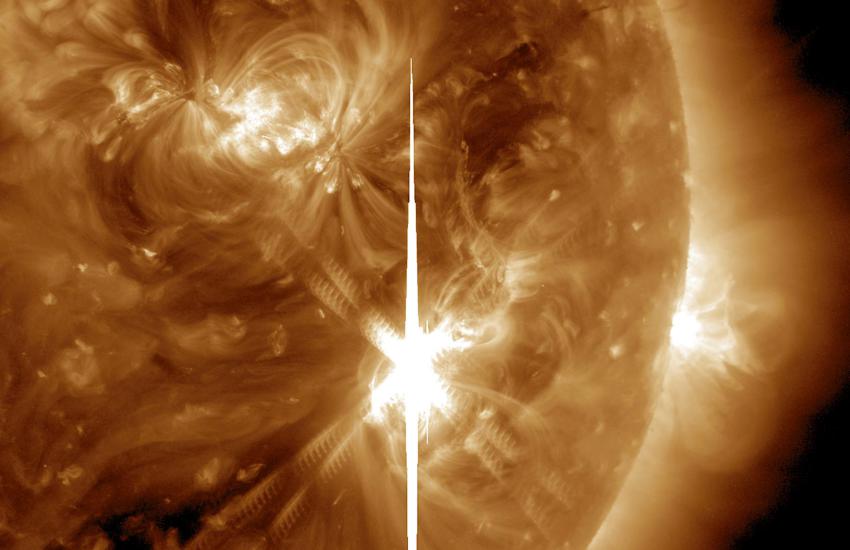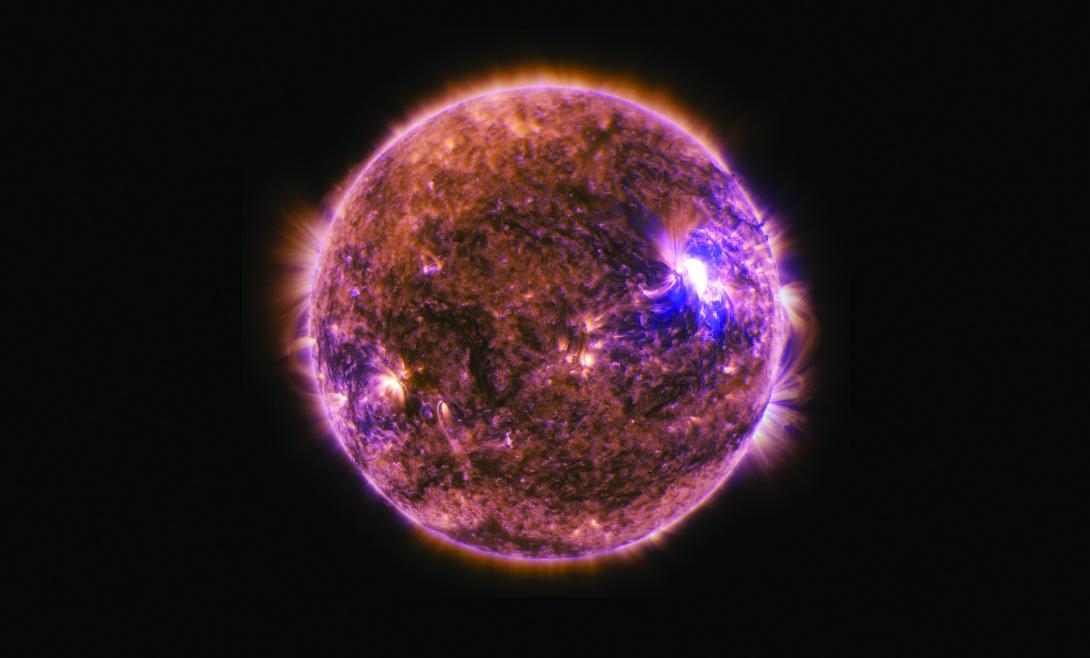Project Helios Develops Solar Flare Prediction Tool
Looking for innovative ways to protect U.S. assets in space, airmen at the Kelly Johnson Joint-All Domain Innovation Center in Michigan examined space-based network defense solutions. In working to address one of the Secretary of the Air Force’s seven operational imperatives—the first of which is resiliency of the space domain—the airmen’s investigation evolved into a follow-on effort called Project Helios. The tool will help identify solar flare events that could damage space-based assets, using a predictive algorithm.
“The byproduct of a solar flare often is disruption to satellite equipment and payloads, and in particular communication satellites,” said Lt. Col. David Brewer, USAF, Air Force Futures, Center 3, Integration and Innovation, who is leading a Michigan Air National Guard team at the Kelly Johnson Joint All-Domain Innovation Center to create the solution. The team is collaborating with Western Michigan University, the National Security Innovation Network and an Air National Guard weather unit to develop for operational use an algorithm paired with a high-performance computing system to predict solar flare events more than 36 hours in advance.
“Solar flares are a significant threat to space-based assets, communication networks and global power grids,” Col. Brewer explained. “The development of an accurate method to predict coronal mass ejections is not currently available as a tool. As indicated by the head of space weather at the European Space Agency Juha-Pekka Luntama, ‘Despite decades of research, scientists still know very little about the activity of the sun and the intricacies of the space weather that it produces.’”
And since the Air Force is dependent on commercial satellites for its so-called remote split operations that fly autonomous drones like the MQ-9 Reaper, the service is vulnerable to the potential impact of a solar flare—which is also called coronal mass ejection (CME) and is defined by NASA as “an intense burst of radiation coming from the release of magnetic energy” associated with sunspots.
“Nellis Air Force Base, they operate MQ-9s,” the colonel stated. “With remote split operations, their network is spread out globally so that we can conduct real-world operations in an area of responsibility but from a distant location. But one of the key vulnerabilities within remote split operations is the satellite network, and we use commercial satellites for that data uplink from the ground support unit, in this case, from Nellis. It has an uplink that goes to a satellite and then the satellite downlinks to the MQ-9. That’s a worldwide ability, but solar flare events have a distinct opportunity to interrupt that.”
The year-long Helios effort will focus on obtaining data and testing the algorithm with additional data to confirm the solution’s veracity. “We are running a 12-month ‘alpha’ test as a proof-of-concept for operational impact in space weather,” Col. Brewer confirmed. “Our team is exploring indication on the sun’s surface using natural patterns, which can be determined with advanced technology, specifically artificial intelligence. Western Michigan University has developed, at the very foundational level, an algorithm to detect and predict CME events.”
The team will take the university’s existing machine learning solution and expose it to more data points so that it becomes more effective in calculating the predictive nature of the solar flares. Western Michigan will retain the rights to the artificial intelligence technology as it partners with the military’s need to have an operational output.
“Ultimately, we’re looking for an algorithm, any algorithm to outperform what a human could do both in accuracy and efficiency,” Col. Brewer noted. “In this specific case, the alpha test, and the 12-month demo is taking the prevetted algorithm, and we’re going to add new data sources to it that would allow it to predict solar flares. It’s actually at a high accuracy rate right now, but we want to broaden it out so that it can adjust more data and provide a longer time frame for the algorithm to be predictive. Currently, the algorithm can predict a future solar flare event or CME event out to 36 hours. With training the algorithm, we suspect that we could go longer.”
The Helios tool obviously would not prevent solar flares, the colonel said, “but it would certainly allow us to operationally respond to a future event. We’d be able to predict the potential for communication breakdowns, for loss of data links, for loss of internet, for the loss of integers. That would make us operationally more agile and more resilient than our adversary nations.”
To aid the output, the Kelly Johnson center purchased a high-powered computer server to house the algorithm and to ingest the data. “The high-performance computing would be for processing speed of two things: to be able to perform the highly complex algorithmic data calculations by the AI [artificial intelligence], but then secondarily, it needs to be able to ingest large amounts of data coming from outside sources,” Col. Brewer described.
The alpha testing will officially begin this month and the team will spend the next year assessing and growing the algorithm with additional data sources in collaboration with possible organizations such as NASA, Massachusetts Institute of Technology Lincoln Labs, National Geospatial-Intelligence Agency, National Reconnaissance Office and the Australian Space Surveillance Telescope (SST). The Australian SST is a joint project between the country’s defense department and the United States’ Defense Advanced Research Projects Agency. “I’d like to grow the data as much as possible, and keeping it as a lowest possible classification is important to us,” the colonel confirmed.
The tool is a timely need, as solar flares are becoming more prevalent.
“Currently, there is an active CME environment,” he said. “Solar flares are becoming more prevalent right now,” he said. “What causes a solar flare is a cool spot on the sun, which creates electromagnetic energy, almost like a vacuum, and then a coronal mass ejection event or solar flare event takes place, and it happens often.
The severity of the event is what is concerning. In a more dramatic storyline, if a solar flare was strong enough and the Earth passed through the CME or the electromagnetic debris that gets cast out, it can blow transformers out on the ground. That’s a very severe case. Obviously, that’s unique. We haven’t really seen that yet. But the more frequent and regular occurrence of CMEs and solar flares can absolutely interrupt and disrupt operations of space-based assets or satellites.”

Solar flares are a significant threat to space-based assets, communication networks, and global power grids. The development of an accurate method to predict coronal mass ejections is not currently available as a tool.

A CME recently impacted the operations of Elon Musk’s Starlink constellation, “taking out Starlink satellites, not all of them, but some of them,” the colonel said. “Enough that it created a large problem, a conundrum for Starlink.” In 2017, NASA recorded the largest solar flare of the last decade, which created a shortwave radio blackout over Europe, Africa and the Atlantic Ocean.
As to whether assets in low-Earth orbit, medium-Earth orbit or geostationary orbit would be more vulnerable to CMEs, Col. Brewer ventures that all space-based assets and satellites are vulnerable. “The orbit by which they operate I wouldn’t say that it would make it more of a severe or a less severe event,” he clarified. “I would say that it would change the probability. For instance, something that’s in low-Earth orbit would pass through a solar flare debris field more prevalently than something that is GEO because of the distance away from the Earth, while [an asset in] GEO might avoid it.”
By December 2023, the colonel hopes to conduct an evaluation of how the tool performed, and with success, move it to the Air Force’s sister service.
“The algorithm will provide data as far as the predictive analysis for solar flares, and we’ll pass that on for inclusion in mission planning events, prior to, and for ongoing operations for MQ-9 remotely piloted aircraft missions out of the Air National Guard base in Michigan, the 110th Wing that conducts MQ-9 operations,” he said. “And as we grow this out with additional data sources, the algorithm will be trained accordingly, and then we will stop the alpha test, make an operational assessment of where the algorithm has had an impact and then make a transition to a sponsor at that point, most likely the U.S. Space Force.”
Col. Brewer acknowledged a few challenges in executing Project Helios, including obtaining a vast amount of diverse data streams, navigating through bureaucracies, handling of network classifications and running down any contracting issues that arise from combining Defense Department and venture-capital constructs in a collaborative way.
“The impact of this initiative will have global impacts on national defense, coalition partners, as well as global networks and communication,” the colonel stated.






Comments